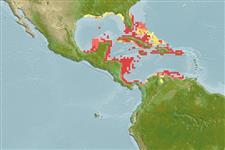Teleostei (teleosts) >
Anguilliformes (Eels and morays) >
Ophichthidae (Snake eels) > Ophichthinae
Etymology: Myrichthys: Greek, myros, -ou = male of morey eel + Greek, ichthys = fish (Ref. 45335).
More on author: Richardson.
Environment: milieu / climate zone / depth range / distribution range
Ecology
Marine; reef-associated; depth range 0 - 9 m. Subtropical; 33°N - 25°S, 95°W - 65°W
Western Atlantic: Bermuda, southern Florida (USA), Bahamas, and Yucatan (Mexico) to the Antilles (Ref. 26340) and northern South America.
Size / Weight / Age
Maturity: Lm ? range ? - ? cm
Max length : 102 cm TL male/unsexed; (Ref. 7251)
Light brown to grayish brown, darker above, with pale spots (Ref. 26938).
Commonly encountered swimming near the bottom in clear water from harbors to reefs. More common along continent and in grassy areas (Ref. 7251). Found in shallow areas to depths of 9 m. Feeds mainly on crabs. (Ref. 26938).
Life cycle and mating behavior
Maturities | Reproduction | Spawnings | Egg(s) | Fecundities | Larvae
Distinct pairing (Ref. 205).
Robins, C.R., R.M. Bailey, C.E. Bond, J.R. Brooker, E.A. Lachner, R.N. Lea and W.B. Scott, 1991. Common and scientific names of fishes from the United States and Canada. Am. Fish. Soc. Spec. Publ. (20):183 p. (Ref. 3814)
IUCN Red List Status (Ref. 130435)
Threat to humans
Harmless
Human uses
Tools
Special reports
Download XML
Internet sources
Estimates based on models
Preferred temperature (Ref.
123201): 26.1 - 28.3, mean 27.5 °C (based on 435 cells).
Phylogenetic diversity index (Ref.
82804): PD
50 = 0.5005 [Uniqueness, from 0.5 = low to 2.0 = high].
Bayesian length-weight: a=0.00089 (0.00039 - 0.00204), b=3.00 (2.80 - 3.20), in cm total length, based on LWR estimates for this (Sub)family-body shape (Ref.
93245).
Trophic level (Ref.
69278): 3.5 ±0.5 se; based on diet studies.
Resilience (Ref.
120179): Medium, minimum population doubling time 1.4 - 4.4 years (Preliminary K or Fecundity.).
Fishing Vulnerability (Ref.
59153): High vulnerability (61 of 100).
Nutrients (Ref.
124155): Calcium = 22.6 [9.9, 50.3] mg/100g; Iron = 0.489 [0.252, 0.990] mg/100g; Protein = 19.6 [17.3, 22.1] %; Omega3 = 0.13 [0.05, 0.36] g/100g; Selenium = 15.6 [7.4, 38.2] μg/100g; VitaminA = 28.2 [7.1, 106.3] μg/100g; Zinc = 0.643 [0.414, 1.011] mg/100g (wet weight);
